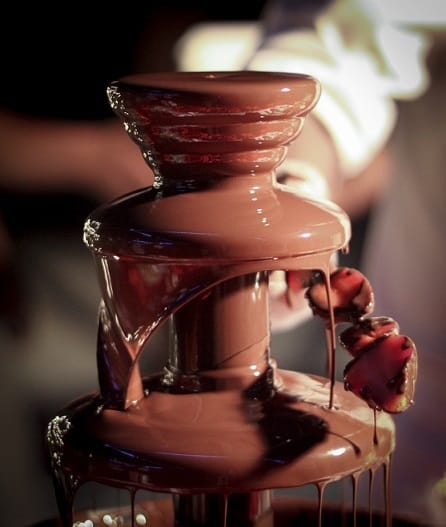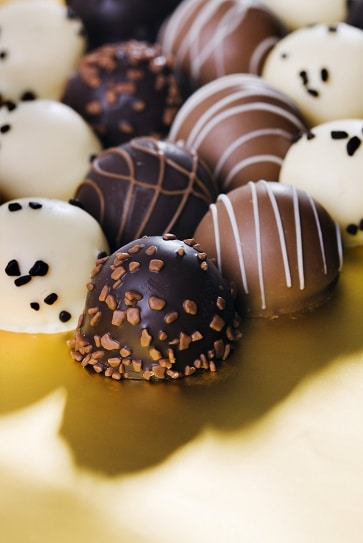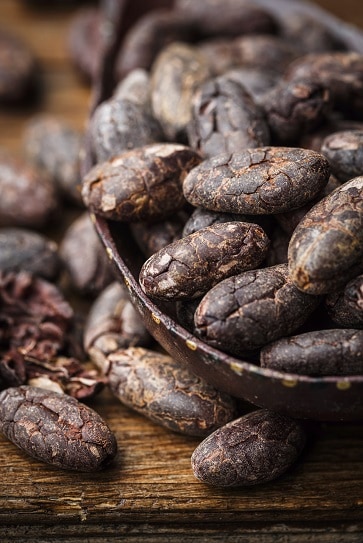 The vast majority of acne sufferers have suspected for years that stress is a massive cause, and if you’re one of them, you’re absolutely correct.
The vast majority of acne sufferers have suspected for years that stress is a massive cause, and if you’re one of them, you’re absolutely correct.
There’s many different pathways, including digestive problems, elevated insulin levels and oily skin, and even delayed wound healing. It’s no fantasy at all if you’ve watched your skin explode with pimples the night before a job interview or competition.
But what you might not realise is that stress hormones aren’t completely controlled by the mind. The main such hormone, cortisol, is synthesised from existing hormones in the body, and certain nutrients such as vitamin C can lower levels in the bloodstream. You have more strategies than simply thinking your way out of chronic stress…
…and that’s where dark chocolate comes in. The world is full of chocoholics, and it always has been (chocolate has been found in 2600-year-old Mayan ceramic jars), but far from having zero willpower, those people have a very well-functioning body. Stressed people are highly drawn to chocolate because it contains numerous compounds that mitigate depression and enhance brain health.
The ancient Mayans knew it well; they first invented the chocolate shower used at weddings. Women, children and common men were forbidden to eat chocolate, since cocoa beans were scarce, but soldiers were given a rudimentary slab to keep their brains sharp and suppress fear as they marched forward into battle.
Cocoa has been the food of love, contentment and happiness for thousands of years, and you too as an acne patient can benefit.
A rare bliss compound
 Chocolate’s first compound is anandamide, a cannabinoid mimic which is derived from the Sanskrit word “Ananda” for bliss.
Chocolate’s first compound is anandamide, a cannabinoid mimic which is derived from the Sanskrit word “Ananda” for bliss.
Firstly, you have to understand how cannabis works in the human brain. The main psychoactive component in the leaf is tetrahydrocannabinol (THC), which binds to THC receptors and stimulates feelings of great well-being and bliss, while slashing stress.
Interestingly though, THC is not manufactured by the human body in any quantity. Nor are we exposed to THC though nature (very few plants contain it). Yet somehow, the receptors still exist. We still have systems in our brain for getting high from it.
Read Annihilate Your Acne – learn to prevent acne and stop just treating it!
What could the answer be? Scientists were puzzled for decades, but in 1996, they discovered a chemical called anandamide in cocoa beans. Later, they discovered that the human brain manufactures anandamide itself, to regulate memory, cognitive function and well-being. This worked by binding to the very same THC receptors that cannabis stimulates.
Other findings were equally interesting. Anandamide does induce pleasure, but it breaks down very rapidly in the brain, yet cocoa apparently contains two compounds which prolong its survival and prolong the euphoria: N-oleoylethanolamine and N-linoleoylethanolamine. Additionally, dark chocolate contains oleamide, a sleep-inducing chemical which increases anandamide levels, and 2-ag, another natural type of cannabinoid.
Anandamide was also discovered recently to contribute to the famous “runners high”, the feeling of extreme euphoria which joggers constantly rave about. It is traditionally attributed to endorphin release, but it turns out that endorphins don’t cross the brain-blood barrier very effectively. Instead, a big release of anandamide was behind the extreme pleasure. Anandamide also regulates movement and controls higher thought processes, possibly including creativity.
While anandamide is found in several other foods, the variety in cocoa reportedly has the strongest bliss-inducing properties.
Anandamide has even been described as a “natural mimic” of marijuana. In fact, there’s a funny story covered in this study, where a pot smoker turned up in court arguing that he’d never touched cannabis; he actually just ate a massive amount of dark chocolate and that’s why his THC receptors were so highly stimulated.
Clearly, this was false, because 1) it would take 25 pounds of dark chocolate to match the cannabinoid stimulation from cannabis, and only a maniac could eat that much in one sitting. Secondly, the stimulants in 25 pounds would give you a guaranteed heart attack anyway, even if you died in chocolatey bliss. In the end, his defence failed and the court convicted him.
The point though, is that dark chocolate’s happiness properties are very real. Right now, there are battles raging all over the globe over cannabis’ future (more on cannabis and acne here), but high-cocoa dark chocolate may be one way to mimic the feeling of bliss and euphoria it provides, albeit in a milder form.
The relaxation mineral
Next, we have the essential mineral magnesium, AKA the “relaxation mineral”.
Magnesium is the joint greatest nutrient with vitamin C for controlling elevated stress hormones. Both nutrients metabolise and eliminate excess cortisol molecules from the bloodstream. One study observed 11% less circulating stress hormones after magnesium supplementation, while another found reduced cortisol both before and after intense exercise.
Better yet, magnesium can bind to and activate gamma aminobutyric acid (GABA) receptors in the brain. GABA is a relaxation neurotransmitter which relieves anxiety, frantic worrying, nervousness and negative thoughts, so stimulating GABA means a weaker signal sent to increase cortisol in the first place.
Vital reading: the top 6 vitamins and minerals for radiant and clear skin
This 2013 meta-analysis of 21 different studies commented that “a higher intake of dietary magnesium seems to be associated with lower depression symptoms”. Perhaps the most fascinating study discovered “a significant association between very low magnesium intake and depression, especially in younger adults”.
Excellent news then – dark chocolate is one of the richest food sources of magnesium available in a grocery store. A standard 50 gram serving contains 29% (108mg) of the RDA. Magnesium deficiency is a pandemic of a condition which affects 80% of Americans.
Special antioxidants
Another natural compound in raw cocoa beans is resveratrol, the heart-protecting, life-extending antioxidant which gives red wine its health benefits.
Resveratrol can also tackle depression, but this time through a different mechanism; increasing brain-derived neurotrophic factor. BDNF encourages the birth and division of new neurons, and can therefore enhance intelligence and memory, but low BDNF is also linked to a low mood.
For instance, killing off BDNF is one way that extreme sugar consumption leads to depression (sugar is a huge cause of acne as well). Resveratrol can increase BDNF activity at the genetic level (study).
This resveratrol study found antidepressant-like activity in rats, and reductions in the stress hormone corticosterone. This mouse study, meanwhile, used a neurochemical analysis and discovered a sharp spike in serotonin after various oral doses of resveratrol.
Serotonin is the main “happiness hormone”, and boosting levels should ward off any negative, stressful thoughts. Reducing depression via BDNF will also prevent those thoughts from spiralling out of control.
Cocoa is a rare strong source of resveratrol in nature, alongside peanuts, Japanese knotweed and red grapes, so that’s yet another explanation of its mood-enhancing reputation.
Lastly, we have epicatechin, a flavanol antioxidant which is a member of the catechin family.
Regular epicatechin is completely different to catechin, epigallocatechin, or epigallocatechin-3-gallate, the fantastic pore-unblocking antioxidant found in green tea. Dark chocolate has the highest epicatechin levels of any food, and its signature skill is mental enhancement:
ONE: epicatechin both lowered anxiety levels and increased brain-derived neurotrophic factor in mice. The conclusion: epicatechin may have beneficial effects on mood (2015 study).
TWO: this 2013 study concluded that epicatechin supplementation was a useful weapon against depression and anxiety disorders in rats.
THREE: epicatechin is able to cross the brain-blood barrier and exert its antioxidant effects there (which should defend neurons against free radicals).
FOUR: again, epicatechin successfully crossed the brain-blood barrier and protected neurons against oxidative stress once there (2002 study).
FIVE: epicatechin supplementation enhanced the memory of mice and triggered the formation of new blood vessels in the brain. Further brain analysis revealed newly formed deposits of epicatechin. The mice were placed in a water maze (sounds like fun), and their performance improved when given epicatechin.
Cocoa powder, dark chocolate, and milk chocolate are king of the castle for epicatechin, with 158.30mg (per 100 grams), 70.36mg, and 14.58mg respectively. That dwarfs many fruits and vegetables which are commonly dubbed “rich sources”, such as the cherry (7.78mg), plum (2.22mg), apricot (3.47mg), strawberry (7.50mg), raspberry (5.05mg), banana (3.47mg), apple with skin (8.37mg), green grape (0.49mg), and blackberry (11.48mg)
If you want to pump your mood up to stratospheric heights by eating epicatechin, you have no choice but to feast on chocolate.
There’s a claim which has been circulating the internet forever that cocoa powder has been proven in scientific studies to increase serotonin levels. I couldn’t locate the study, and maybe it doesn’t even exist, but we have studies covering resveratrol. Magnesium is a direct precursor to serotonin, and epicatechin may be a miracle, assuming it’s absorbed through the gastrointestinal tract, which studies suggest it is.
The greatness of cocoa in studies
 So far the signs are excellent, but all these magical compounds would be meaningless if the overall food of cocoa failed to reduce stress levels.
So far the signs are excellent, but all these magical compounds would be meaningless if the overall food of cocoa failed to reduce stress levels.
What if there was one devious compound, like the cocoa stimulant theobromine, for example, which cranked up stress hormones massively and blew away all the beneficial effects? It’s happened before, notably with coffee and its caffeine. You always have to consider an overall food rather than a single isolated compound…
…but luckily, dark chocolate itself has many excellent stress studies, and the first covered 65 healthy men aged between 20 and 50 years, who were non-smoking and medication free.
34 men ate a 72% cocoa dark chocolate containing 125mg of epicatechin, whereas 31 took the placebo, a white chocolate bar that had been dyed brown to trick everyone into thinking it was dark chocolate. To induce stress, all 65 men performed the same mental arithmetic test, in front of an audience.
While both groups had similar stress hormones originally, “the dark chocolate group showed a significantly blunted cortisol… reactivity to psychosocial stress compared to the placebo group”.
Why zinc supplements can reduce acne by 49.8%
Most importantly, the dark chocolate had huge benefits, yet the white chocolate didn’t accomplish anything. This homes in on the cocoa powder, proving that it’s where the stress-busting benefits lie, rather than cocoa butter, vanilla or sugar. The white chocolate bar had 0mg of epicatechins compared to 125mg. Even the dark chocolate was only 72% cocoa solids, which is great news, because I normally recommend 85%.
Secondly, we have a 2009 study by the Nestle Research Centre. Now, you would expect that these results are totally crooked, because the Nestle Corporation has a big incentive to prove that chocolate has massive health benefits, but the methodology was decent and the findings are in line with the other studies.
30 human volunteers were divided into low-anxiety and high-anxiety groups and then forced to eat 40 grams of dark chocolate daily. They were “free-living” subjects; their remaining lifestyle and diet wasn’t controlled.
After two weeks, cortisol levels in the high-anxiety patients had fallen substantially, and better yet, the damage to energy metabolism and healthy gut bacteria triggered by high cortisol was prevented. Crippling digestion is a key method behind cortisol’s acne dangers.
That’s another bullseye for dark chocolate then, albeit with a moderate corruption disclaimer. Finally, we have a 2009 study which fed volunteers 1.5 ounces (42 grams) of dark chocolate daily. The volunteers were “highly stressed”, but two weeks later, they had substantially lower levels of the stress hormone cortisol.
It’s clear that dark chocolate’s stress benefits do exist in the real world, that the fantastic compounds aren’t blocked by any hidden spoilers.
How to eat chocolate for stress?
 Your instructions are virtually identical to eating it for other acne benefits.
Your instructions are virtually identical to eating it for other acne benefits.
Eating milk chocolate as anything other than a treat is a fool’s errand; the beneficial compounds we just covered are concentrated in the cocoa portion of the chocolate, not the sugar.
In fact, milk may inhibit the absorption of chocolate antioxidants (study). Dark chocolate with milk and milk chocolate failed to increase bloodstream antioxidants, whereas dark chocolate alone did. 85% dark is the greatest balance between sweetness, health benefits and flavour.
As for the quantity, we have a mystery on our hands due to the alkaloid stimulant theobromine. Theobromine is a structural analog of caffeine; it has similar but much milder effects. These include the classic heart-rate increase, mental focus, energy burst, and inability to sleep. The side effects such as nervousness, nausea and vomiting are far milder than caffeine, except for increasing heart rate by a greater degree. Consequently, it is touted by many as a secret, superior stimulant if you cannot tolerate caffeine, but stress hormones are one area where theobromine remains mysterious.
Coffee is actually healthy for acne overall, but drinking more than three cups per day is unwise. Why? Caffeine is notorious for spiking cortisol levels, by up to 52%. That’s where some of the nervousness and anxiety comes from.
As a stimulant which is only a couple of molecules away from caffeine, theobromine could easily do the same. There are no studies analysing it, so we don’t know. However, my gut feeling is that theobromine does spike cortisol when eaten in huge amounts, because the other overdose symptoms are so similar (albeit milder) to caffeine.
Recommended – the 7 greatest natural topical treatments for acne
The two studies above concluded that 40 and 42 grams of dark chocolate could slash stress significantly. Therefore, the sweet spot for acne will be about 50 grams daily.
Going higher than 100 grams is unnecessary and possibly detrimental. If you notice side effects such as jitteriness and a pumping heartbeat, that’s a sign you’ve eaten too much.
Conclusion
Eating 85% or even 70% dark chocolate is one of the best biological hacks for slashing stress, and all the acne stemming from it.
The ultimate stress-busting strategy is to eliminate the sources of mental anxiety in your life, but nutrients such as vitamin C and magnesium clear out excess cortisol in the bloodstream. Pomegranate can inhibit the conversion of cortisone, the less active form, to fully-fledged cortisol. Olive oil contains a phenolic antioxidant called oleuropein which can halve cortisol levels in rats (study).
Dark chocolate is easily one of the ultimate happiness-inducing foods, and not just because of its taste.
NEXT: read the 167 page eBook and get the ultimate diet for acne
Thanks for reading!

Hi, what are your thoughts on chocolate processed with alkali? Is it bad for acne?
No, but it’s slightly less nutritious! Still effective though, but it’s not the maximum acne-clearing weapon. The alkaline processing, AKA “dutching” decreases the antioxidant count. Lindt is an example of dutched chocolate.
so in the beginning you mentioned the several ways stress can cause acne. but how severe can it make it? ive had a predisposition to acne but havent always had it, and when i did get it would never linger or leave marks. now it can linger for weeks, leave a small uncolored bump, or cause hyper pigmentation, and it is starting to get worse, and im getting breakouts on my skin where i have never had it before. i strongly suspect this is all because of stress, and was wondering if that could be the cause of it all, and if i should put my focus all on stress reduction?